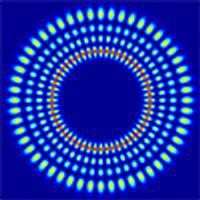当前位置:
X-MOL 学术
›
Adv. Opt. Photon.
›
论文详情
Our official English website, www.x-mol.net, welcomes your feedback! (Note: you will need to create a separate account there.)
Mathematics of vectorial Gaussian beams
Advances in Optics and Photonics ( IF 27.1 ) Pub Date : 2019-11-06 , DOI: 10.1364/aop.11.000828 Uri Levy , Yaron Silberberg , Nir Davidson
Advances in Optics and Photonics ( IF 27.1 ) Pub Date : 2019-11-06 , DOI: 10.1364/aop.11.000828 Uri Levy , Yaron Silberberg , Nir Davidson

|
Since the development of laser light sources in the early 1960s, laser beams are everywhere. Laser beams are central in many industrial applications and are essential in ample scientific research fields. Prime scientific examples are optical trapping of ultracold atoms, optical levitation of particles, and laser-based detection of gravitational waves. Mathematically, laser beams are well described by Gaussian beam expressions. Rather well covered in the literature to date are basic expressions for scalar Gaussian beams. In the past, however, higher accuracy mathematics of scalar Gaussian beams and certainly high-accuracy mathematics of vectorial Gaussian beams were far less studied. The objective of the present review then is to summarize and advance the mathematics of vectorial Gaussian beams. When a weakly diverging Gaussian beam, approximated as a linearly polarized two-component plane wave, say (Ex,By), is tightly focused by a high-numerical-aperture lens, the wave is “depolarized.” Namely, the prelens (practically) missing electric field Ey,Ez components suddenly appear. This is similar for the prelens missing Bx,Bz components. In fact, for any divergence angle (θd<1), the ratio of maximum electric field amplitudes of a Gaussian beam Ex:Ez:Ey is roughly 1:θd2:θd4. It follows that if a research case involves a tightly focused laser beam, then the case analysis calls for the mathematics of vectorial Gaussian beams. Gaussian-beam-like distributions of the six electric–magnetic vector field components that nearly exactly satisfy Maxwell’s equations are presented. We show that the near-field distributions with and without evanescent waves are markedly different from each other. The here-presented nearly exact six electric–magnetic Gaussian-beam-like field components are symmetric, meaning that the cross-sectional amplitude distribution of Ex(x,y) at any distance (z) is similar to the By(x,y) distribution, Ey(x,y) is similar to Bx(x,y), and a 90° rotated Ez(x,y) is similar to Bz(x,y). Components’ symmetry was achieved by executing the steps of an outlined symmetrization procedure. Regardless of how tightly a Gaussian beam is focused, its divergence angle is limited. We show that the full-cone angle to full width at half-maximum intensity of the dominant vector field component does not exceed 60°. The highest accuracy field distributions to date of the less familiar higher-order Hermite–Gaussian vector components are also presented. Hermite–Gaussian E-B vectors only approximately satisfy Maxwell’s equations. We have defined a Maxwell’s-residual power measure to quantify the approximation quality of different vector sets, and each set approximately (or exactly) satisfies Maxwell’s equations. Several vectorial “applications,” i.e., research fields that involve vector laser beams, are briefly discussed. The mathematics of vectorial Gaussian beams is particularly applicable to the analysis of the physical systems associated with such applications. Two user-friendly “Mathematica” programs, one for computing six high-accuracy vector components of a Hermite–Gaussian beam, and the other for computing the six practically Maxwell’s-equations-satisfying components of a focused laser beam, supplement this review.
中文翻译:

矢量高斯光束的数学
自从1960年代初期激光光源的发展,激光束无处不在。激光束在许多工业应用中处于核心地位,并且在众多科学研究领域中必不可少。主要的科学例子是超冷原子的光学捕获、粒子的光学悬浮以及基于激光的引力波探测。在数学上,激光束可以用高斯光束表达式很好地描述。迄今为止,在文献中相当详尽的是标量高斯光束的基本表达式。然而,在过去,对标量高斯光束的高精度数学和矢量高斯光束的高精度数学的研究要少得多。本综述的目的是总结和推进矢量高斯光束的数学。当弱发散的高斯光束时,近似为线性偏振的双分量平面波,例如 (Ex,By),由高数值孔径透镜紧密聚焦,波被“去偏振”。即,预透镜(实际上)缺少电场 Ey,Ez 分量突然出现。这与缺少 Bx,Bz 组件的预透镜类似。事实上,对于任何发散角(θd<1),高斯光束 Ex:Ez:Ey 的最大电场幅度之比大约为 1:θd2:θd4。因此,如果研究案例涉及紧密聚焦的激光束,则案例分析需要矢量高斯光束的数学知识。呈现了几乎完全满足麦克斯韦方程组的六个电磁矢量场分量的高斯束状分布。我们表明,有和没有倏逝波的近场分布彼此明显不同。这里提出的几乎精确的六个电磁高斯束状场分量是对称的,这意味着 Ex(x,y) 在任何距离 (z) 处的横截面振幅分布类似于 By(x,y) ) 分布,Ey(x,y) 类似于 Bx(x,y),旋转 90° 的 Ez(x,y) 类似于 Bz(x,y)。组件的对称性是通过执行概述的对称化过程的步骤来实现的。无论高斯光束聚焦得有多紧,其发散角都是有限的。我们表明,主要矢量场分量的半最大强度处的全锥角与全宽的夹角不超过 60°。还提供了迄今为止不太熟悉的高阶 Hermite-Gaussian 矢量分量的最高精度场分布。Hermite-Gaussian EB 向量仅近似满足麦克斯韦方程组。我们已经定义了一个麦克斯韦剩余功率度量来量化不同矢量集的近似质量,并且每组近似(或完全)满足麦克斯韦方程组。简要讨论了几种矢量“应用”,即涉及矢量激光束的研究领域。矢量高斯光束的数学特别适用于与此类应用相关的物理系统的分析。两个用户友好的“Mathematica”程序,一个用于计算 Hermite-Gaussian 光束的六个高精度矢量分量,
更新日期:2019-11-06
中文翻译:

矢量高斯光束的数学
自从1960年代初期激光光源的发展,激光束无处不在。激光束在许多工业应用中处于核心地位,并且在众多科学研究领域中必不可少。主要的科学例子是超冷原子的光学捕获、粒子的光学悬浮以及基于激光的引力波探测。在数学上,激光束可以用高斯光束表达式很好地描述。迄今为止,在文献中相当详尽的是标量高斯光束的基本表达式。然而,在过去,对标量高斯光束的高精度数学和矢量高斯光束的高精度数学的研究要少得多。本综述的目的是总结和推进矢量高斯光束的数学。当弱发散的高斯光束时,近似为线性偏振的双分量平面波,例如 (Ex,By),由高数值孔径透镜紧密聚焦,波被“去偏振”。即,预透镜(实际上)缺少电场 Ey,Ez 分量突然出现。这与缺少 Bx,Bz 组件的预透镜类似。事实上,对于任何发散角(θd<1),高斯光束 Ex:Ez:Ey 的最大电场幅度之比大约为 1:θd2:θd4。因此,如果研究案例涉及紧密聚焦的激光束,则案例分析需要矢量高斯光束的数学知识。呈现了几乎完全满足麦克斯韦方程组的六个电磁矢量场分量的高斯束状分布。我们表明,有和没有倏逝波的近场分布彼此明显不同。这里提出的几乎精确的六个电磁高斯束状场分量是对称的,这意味着 Ex(x,y) 在任何距离 (z) 处的横截面振幅分布类似于 By(x,y) ) 分布,Ey(x,y) 类似于 Bx(x,y),旋转 90° 的 Ez(x,y) 类似于 Bz(x,y)。组件的对称性是通过执行概述的对称化过程的步骤来实现的。无论高斯光束聚焦得有多紧,其发散角都是有限的。我们表明,主要矢量场分量的半最大强度处的全锥角与全宽的夹角不超过 60°。还提供了迄今为止不太熟悉的高阶 Hermite-Gaussian 矢量分量的最高精度场分布。Hermite-Gaussian EB 向量仅近似满足麦克斯韦方程组。我们已经定义了一个麦克斯韦剩余功率度量来量化不同矢量集的近似质量,并且每组近似(或完全)满足麦克斯韦方程组。简要讨论了几种矢量“应用”,即涉及矢量激光束的研究领域。矢量高斯光束的数学特别适用于与此类应用相关的物理系统的分析。两个用户友好的“Mathematica”程序,一个用于计算 Hermite-Gaussian 光束的六个高精度矢量分量,



























 京公网安备 11010802027423号
京公网安备 11010802027423号